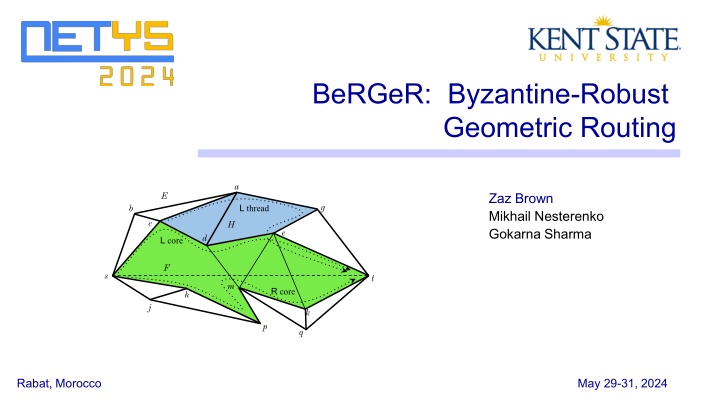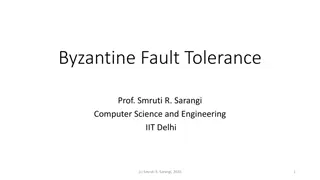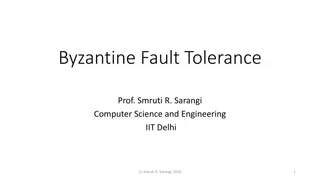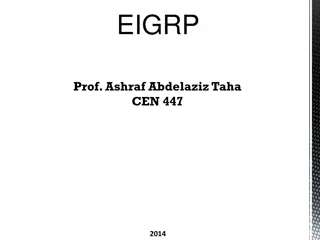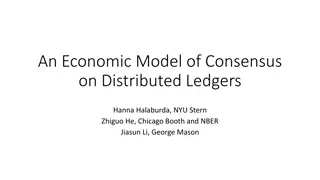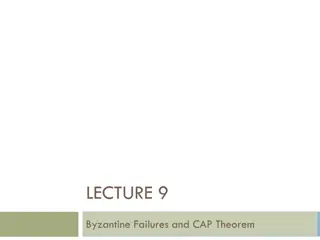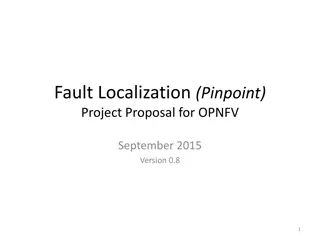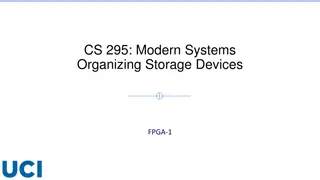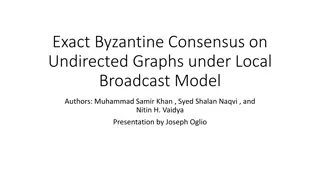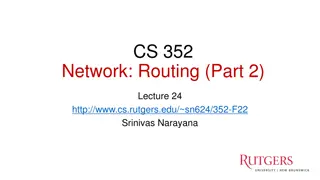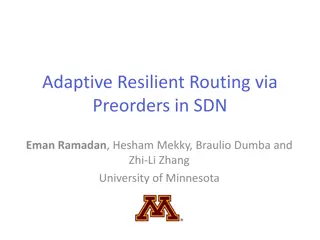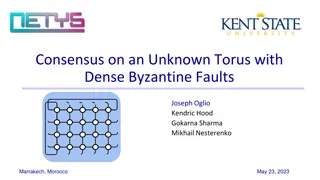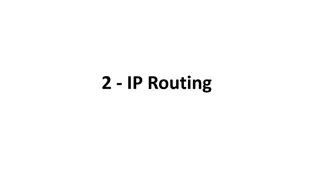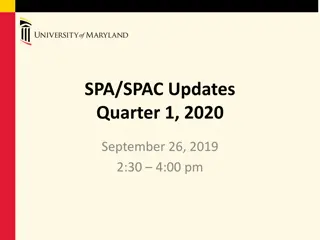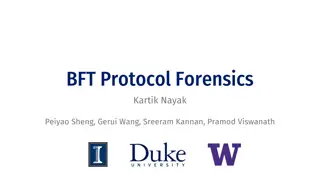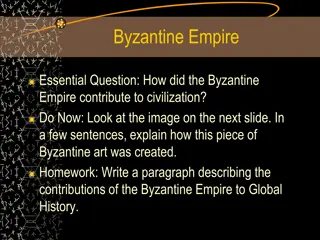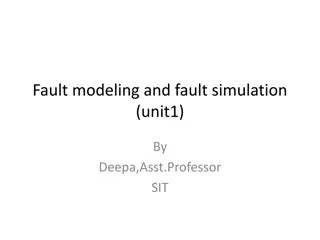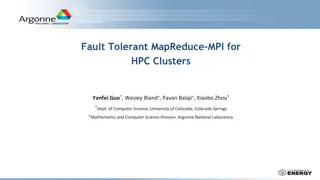Geometric Routing Concepts and Byzantine Fault Tolerance
Geometric Routing enables routing without overhead, where each node knows its global coordinates and forwards messages based on proximity to the destination. Byzantine Faults pose challenges with arbitrary node behavior, but a Byzantine-Robust Geometric Routing algorithm addresses this in a 3-connected planar graph. The outline covers key terms and operations for correct routing, including unit disk graphs and routing assumptions like the right-hand rule. Explore how these concepts contribute to efficient and fault-tolerant routing strategies.
Download Presentation

Please find below an Image/Link to download the presentation.
The content on the website is provided AS IS for your information and personal use only. It may not be sold, licensed, or shared on other websites without obtaining consent from the author.If you encounter any issues during the download, it is possible that the publisher has removed the file from their server.
You are allowed to download the files provided on this website for personal or commercial use, subject to the condition that they are used lawfully. All files are the property of their respective owners.
The content on the website is provided AS IS for your information and personal use only. It may not be sold, licensed, or shared on other websites without obtaining consent from the author.
E N D
Presentation Transcript
BeRGeR: Byzantine-Robust Geometric Routing a Zaz Brown Mikhail Nesterenko Gokarna Sharma E L thread g b c H e d L core F s t m R core h j k p q Rabat, Morocco May 29-31, 2024
Geometric Routing: Routing without Overhead static nodes, each node knows its global coordinates, source knows coords of target little overhead no routing tables: each node only knows coords of neighbors no memory: no info kept at node after message is routed no global knowledge simple approaches flooding expensive greedy routing message carries coords of target each node forwards to neighbor closer to destination problem: local minimum what if no closer neighbor? use face routing on planar graph a E L thread g b c H e d L core F s t m R core h j k p q 2
Geometric Routing with Byzantine Faults problem: Byzantine fault: arbitrary node behavior, hardest to counter, can model either faults or intruders in general, requires 2f+1 connectivity can we find 3 disjoint paths offline? Byzantine node resists topology discovery question: can we do geometric routing with Byzantine fault? a E L thread g b c solution: BeRGeR: Byzantine-Robust Geometric Routing algorithm single Byzantine fault 3-connected planar graph (more details later) H e d L core F s t m R core h j k p q 3
Outline geometric routing concepts BeRGeR terms operation correctness a E L thread g b c H e d L core F s t m R core h j k p q 4
Graph Terms unit disk graph: two vertices are adjacent iff they are within unit distance approximates radio model planar (embedding) graph can be effectively constructed from a unit disk graph source (s), target (t) vertices, st-line coords assumed carried by message face: area where any two points can be connected by a line not intersecting graph edges single infinite external face a E L thread g b c H e d L core F s t m R core h j k p q 5
Routing Terms and Assumptions right-hand-rule: if node receives left message, node forwards message to next clockwise from sender node traverses internal face clockwise similar left-hand-rule geometric routing assumptions reliable transmission asynchronous communication atomic message sent/receipt a E L thread g b c H e d L core F s t m R core h j k p q 6
Outline geometric routing concepts BeRGeR terms operation correctness a E L thread g b c H e d L core F s t m R core h j k p q 7
BeRGeR Definitions a E g b c e d s t m h j k p q 8
BeRGeR Definitions green face: union of faces that lie on the s-t line a E g b c e d F s t m h j k p q 9
BeRGeR Definitions green face: union of faces that lie on the s-t line a E g G s t: the graph minus the edges that intersect the s-t line b c e d F s t m h j k p q 10
BeRGeR Definitions green face: union of faces that lie on the s-t line a E g G s t: the graph minus the edges that intersect the s-t line b c e d d-blue face: union of the faces adjacent to green face and d F s t m h j k p q 11
BeRGeR Definitions green face: union of faces that lie on the s-t line a E g G s t: the graph minus the edges that intersect the s-t line b c e d L core d-blue face: union of the faces adjacent to green face and d F core: traverses green face either left or right s t R core m h j k p q 12
BeRGeR Definitions green face: union of faces that lie on the s-t line a E d thread g G s t: the graph minus the edges that intersect the s-t line b c e L core d d-blue face: union of the faces adjacent to green face and d F core: traverses green face either left or right s t R core m h d-thread: traverses the union of green face and d-blue face, left or right j k p q 13
Outline geometric routing concepts BeRGeR terms operation correctness a E L thread g b c H e d L core F s t m R core h j k p q 14
BeRGeR Operation: Cores a E g b c e d s t m h j k p q 15
BeRGeR Operation: Cores s originates 2 cores: L core R core a E g b c e L core d F s t R core m h j k p q 16
BeRGeR Operation: Cores s originates 2 cores: L core R core a E g b c they visit the next node clockwise or counterclockwise on the current face e L core d F s t R core m h j k p q 17
BeRGeR Operation: Cores s originates 2 cores: L core R core a E g b c they visit the next node clockwise or counterclockwise on the current face e L core d F excluding nodes that are on the other side of the st-line s t R core m h j k p q 18
BeRGeR Operation: Cores s originates 2 cores: L core R core a E g b c they visit the next node clockwise or counterclockwise on the current face e L core d excluding nodes that are on the other side of the st-line F s t R core m h j k p q 19
BeRGeR Operation: Cores s originates 2 cores: L core R core a E g b c they visit the next node clockwise or counterclockwise on the current face e L core d excluding nodes that are on the other side of the st-line F s t R core m h two matching cores arrive at t j k p q 20
BeRGeR Operation: Cores s originates 2 threads: c-thread (left) h-thread (right) a E g b c e L core d F s t R core m h j k p q 21
BeRGeR Operation: Cores s originates 2 threads: c-thread (left) h-thread (right) a E g b H c is about to originate the d-thread. c e L core d F s t R core m h j k p q 22
BeRGeR Operation: Cores s originates 2 threads: c-thread (left) h-thread (right) a E d-thread g b H c is about to originate the d-thread. c e L core d d-thread obeys left-hand rule F s t R core m h j k p q 23
BeRGeR Operation: Cores s originates 2 threads: c-thread (left) h-thread (right) a E d-thread g b H c is about to originate the d-thread. c e L core d d-thread obeys left-hand rule except that it ignores d. F s t R core m h j k p q 24
BeRGeR Operation: Cores s originates 2 threads: c-thread (left) h-thread (right) a E d-thread g b H c is about to originate the d-thread. c e L core d d-thread obeys left-hand rule except that it ignores d. F s t R core m threads continue to follow left or right hand rule h j k p q 25
BeRGeR Operation: Braids s originates 2 threads: c-thread (left) h-thread (right) a E d-thread g b H c is about to originate the d-thread. c e L core d d-thread obeys left-hand rule except that it ignores d. F s t R core m threads continue to follow left or right hand rule h j k p q 26
Outline geometric routing concepts BeRGeR terms operation correctness a E L thread g b c H e d L core F s t m R core h j k p q 27
Correctness: Lemma 1 & 2 a E Lemma 1. A core packet traverses a single face of G s t and a thread skipping node k traverses a single face of G s t { k }. L thread g b c H e d L core intuition: s sends left core (L) using left-hand-rule, n green face, excludes edges interesting st-line, right core (R) similar F s t m R core h d-thread skips d and traverses blue face j k p q Lemma 2. Left and right core paths are internally node-disjoint. proof by contradiction suppose there is a node v on both core paths all paths from s to t must pass through v this violates the Triconnectivity Assumption v s t F 28
Correctness: Lemma 3 & 4 Lemma 3 (Core validity). If the target receives a left core and a right core carrying messages m and m respectively and m = m , then m = m a E proof L thread g b Lemma 1 cores traverse only the green face Lemma 2 the core paths are node disjoint there is only 1 Byzantine node so the Byzantine node cannot affect both cores c H e d L core F s t m R core h j k p Lemma 4 (Thread validity). If a thread skips a green node k and reaches a correct node, it is not originated by k. q proof If k originates a thread that skips k, that thread is immediately dropped If k originates a core, that core contains k in its visited list a correct node never originates a thread that skips any node in 29
Correctness: Lemma 5 & 6 Lemma 5. The path traversed by a left thread does not contain any node of the right core path. Similarly, the path traversed by the right thread does not contain nodes of the left core path. H proof by contradiction suppose there is a node v on the left k-thread path and the right core path all paths from s to t must pass through v or k this violates the Triconnectivity Assumption k v s t F Lemma 6 (Braid validity). If the fault is adjacent to the green face and the target receives a core and a matching braid carrying m, then m = m . proof Lemma 5 left thread path is disjoint from right core path there is only 1 Byzantine node so the Byzantine node cannot affect both a left thread path and a right core path 30
Correctness: Liveness & Termination Lemma 7 (Liveness). The target eventually receives either (i) matching left and right core packets or (ii) a matching core and a braid. proof if the faulty node is not on the green face, then matching cores reach target if the faulty node is on the green face, then a matching core and braid reach target a Lemma 8. Every packet is forwarded a finite number of times. E L thread g b intuition The algorithm works by excluding nodes from consideration then routing either clockwise or counterclockwise. c H e d L core F s t So the packets are guaranteed to eventually arrive back at the sender. At which point they will be dropped. m R core h j k p q 31
BeRGeR Correctness Proof Theorem 1. BeRGeR: Byzantine Robust Geometric Routing algorithm solves the Reliable Message Delivery Problem with a single Byzantine node in a planar graph subject to the Triconnectivity Assumption. proof to prove this, we need to show 3 things: validity an incorrect message is never delivered Lemma 3 & 6 a E liveness the correct message is eventually delivered Lemma 7 L thread g b c H e d L core termination the algorithm terminates Lemma 8 F s t m R core h j k p q 32
BeRGeR: Debrief BeRGeR: fist algorithm to do Byzantine-robust geometric routing complexity: O(|N| ) can extend to constant packet size if nodes are stateful future: evaluate performance max planar graph connectivity is 5: investigate if can tolerate 2 faults investigate relaxing the Triconnectivity Assumption a E L thread g b c H QUESTIONS? e d L core F s t m R core h j k p q 33
